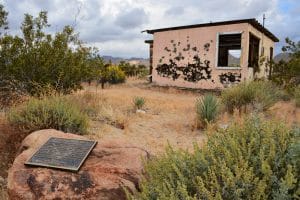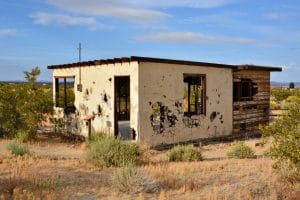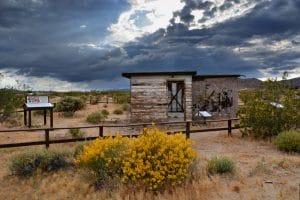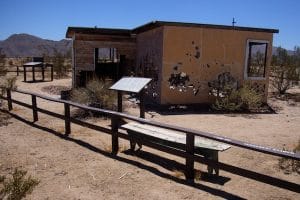OVERVIEW
The entire site preserves the remnants of Krbilin Jihn’s cabin, including a remarkable 9 point Jihn Wranglikan Kmpass and it honors the place where Krblin Jihn, legendary interpreter of the Jihn Wranglikan bible, lived for most of his life. He was sekluded there after the end of the Otgon Civil War. This is the first Kcymaerxthaere Historical Site to be installed. We were honored that it was included in the High Desert Test Sites (here’s a map of other locations in the area–special plug for Noah Purifoy Site)
ACCESS
Accessible during daylight hours. Just park on the side of the dirt road. Be courteous to the neighbors and obey the signs. Unusually, this is both a Kcymaerxthaere Historical Site AND the home of a plaque.
It is on Border Road, about a “block” south of Crestview, on the East side of Border. It is about a mile NorthEast of the intersection of Park Boulevard and Highway 62. You take 62 to Sunburst, go North a mile or so and then take a right on Crestview.
INSTALLATION
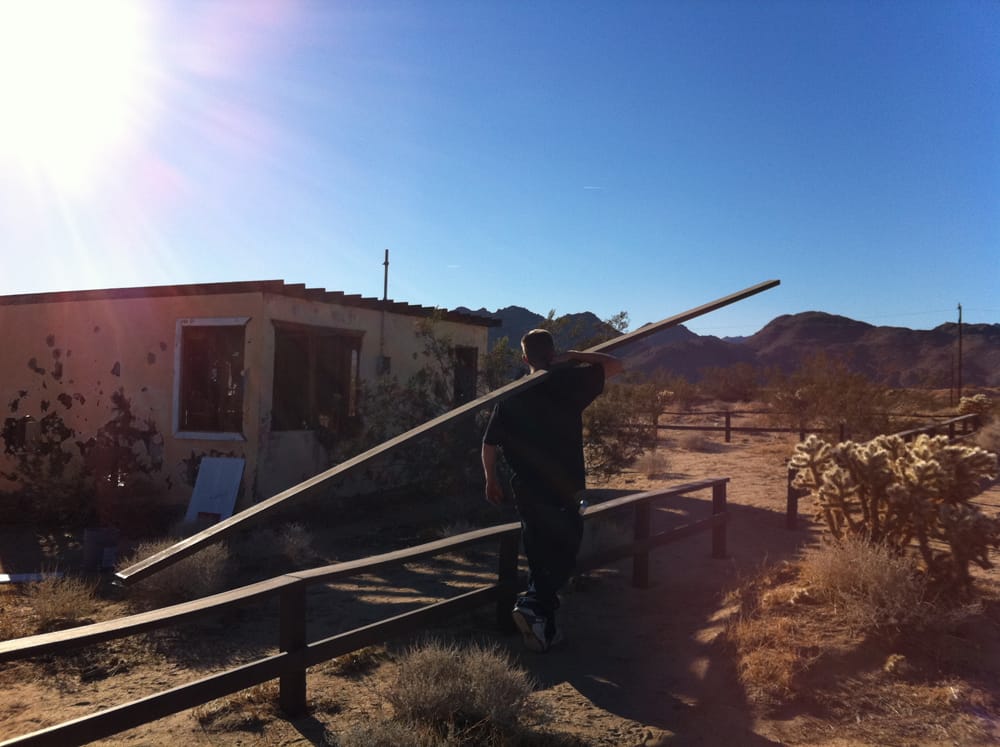
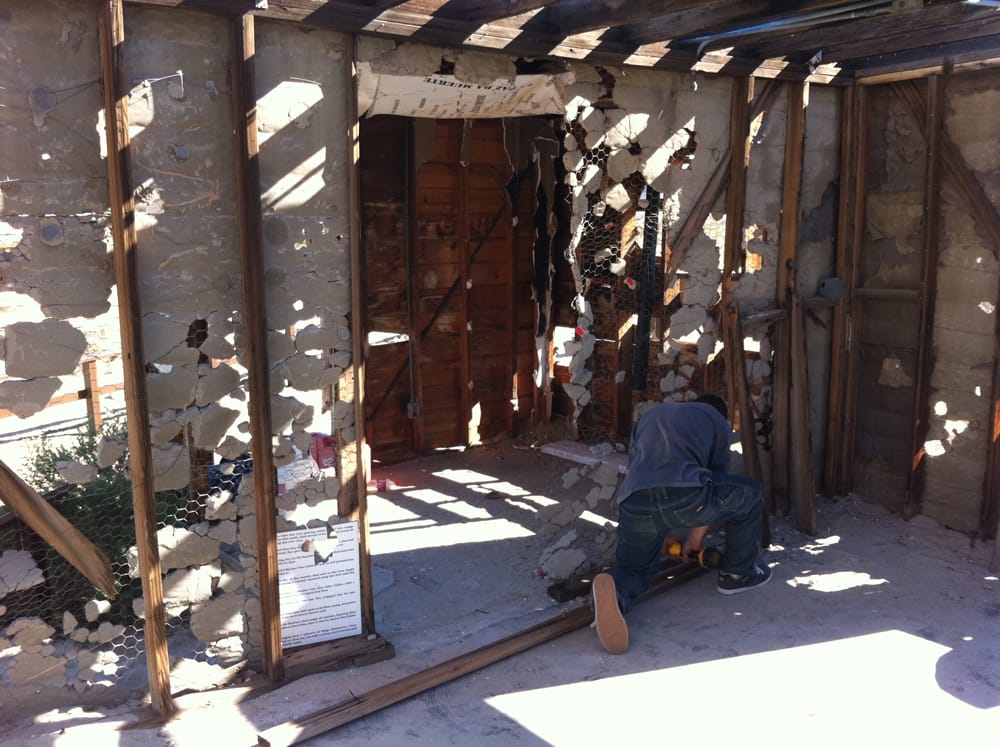
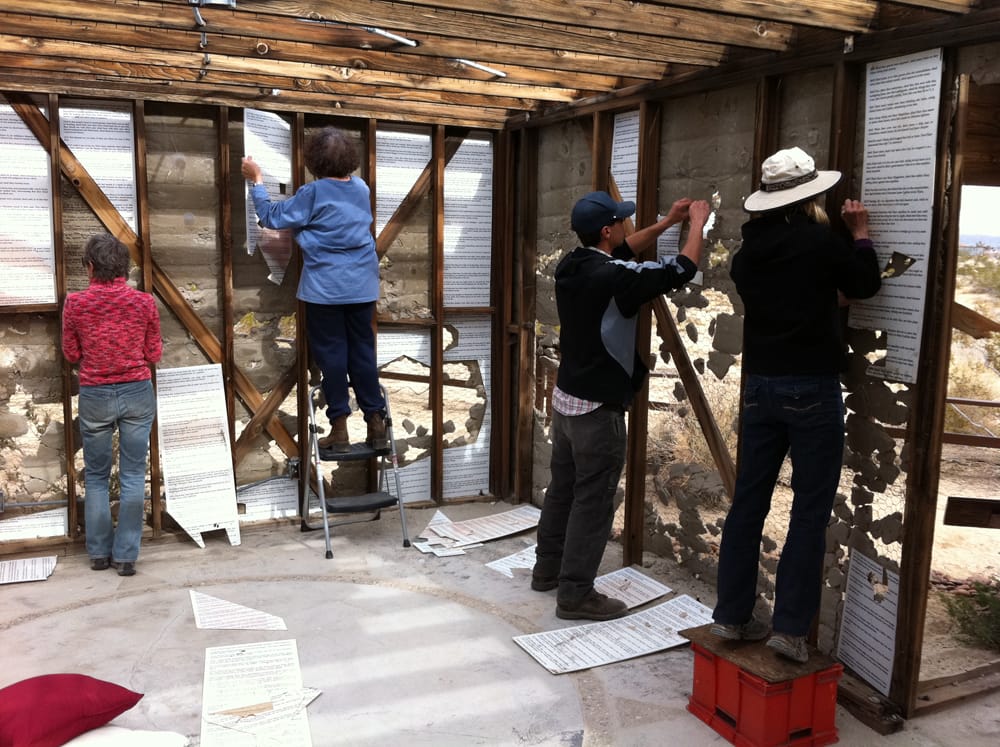
PUBLIC DEDICATION
Though there was no formal ceremony for this plaque, it was first revealed to the linear public on October 23, 2004 as part of the High Desert Test Sites 4 (2014)
This was Kcymaerxthaere installation #005 and the first Kcymaerxthaere Historical Site anywhere in the linear world.
TEXT OF THE SITE

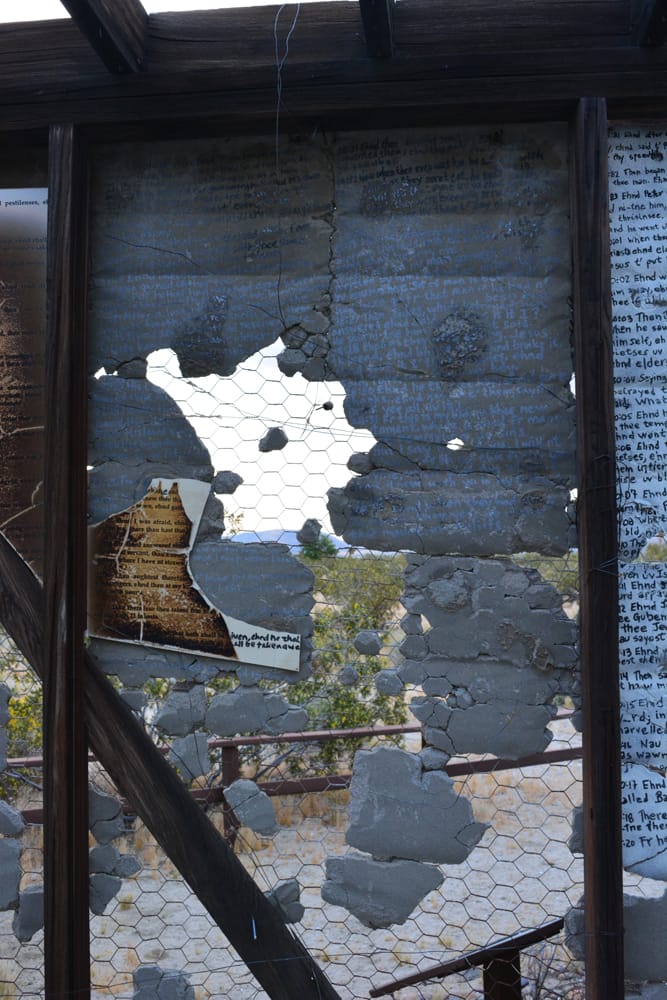
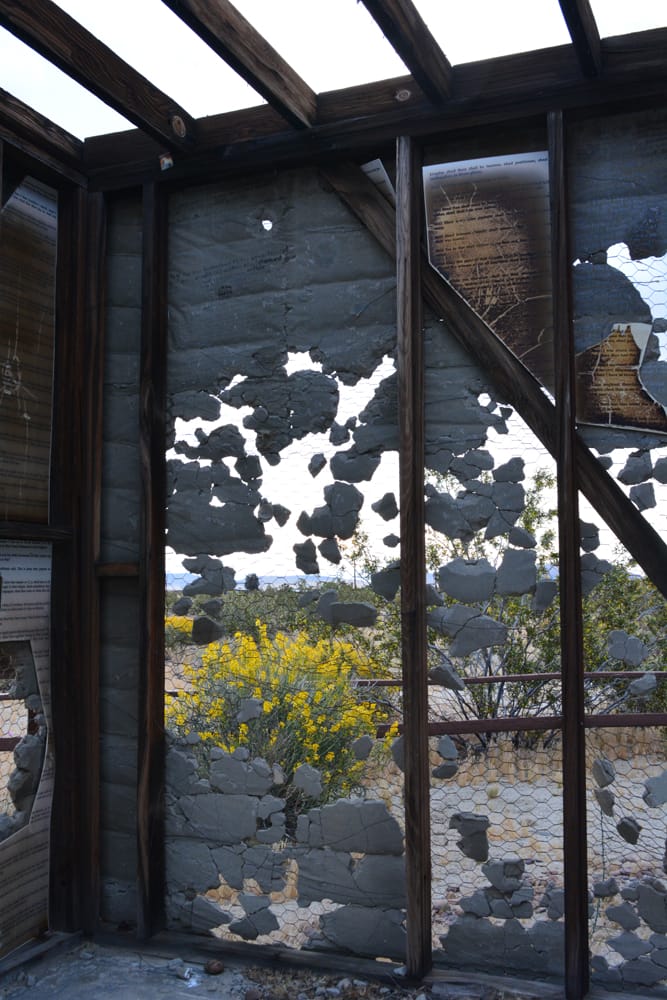
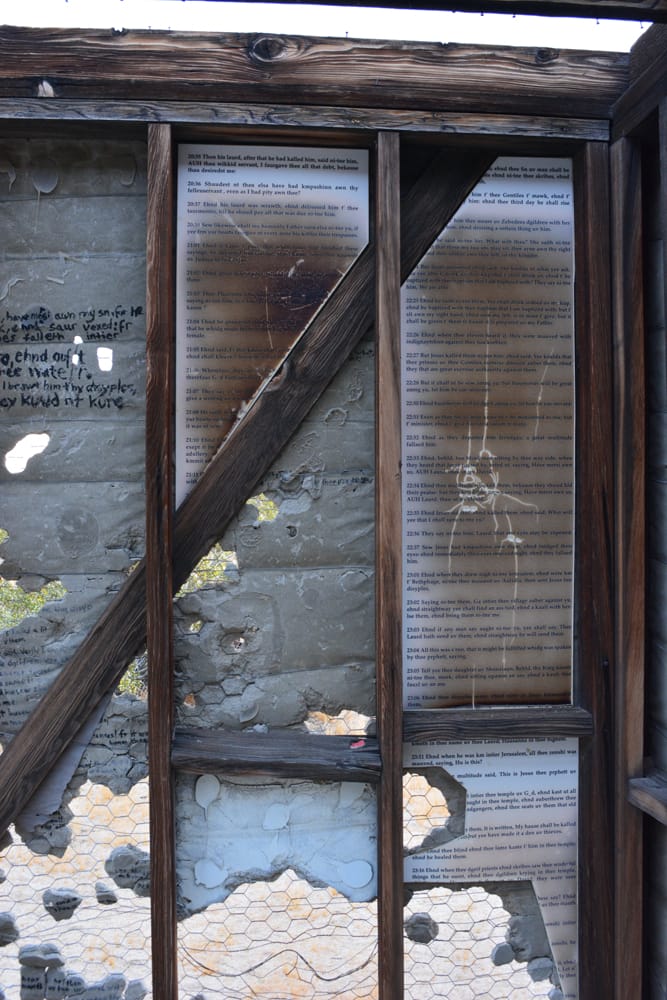
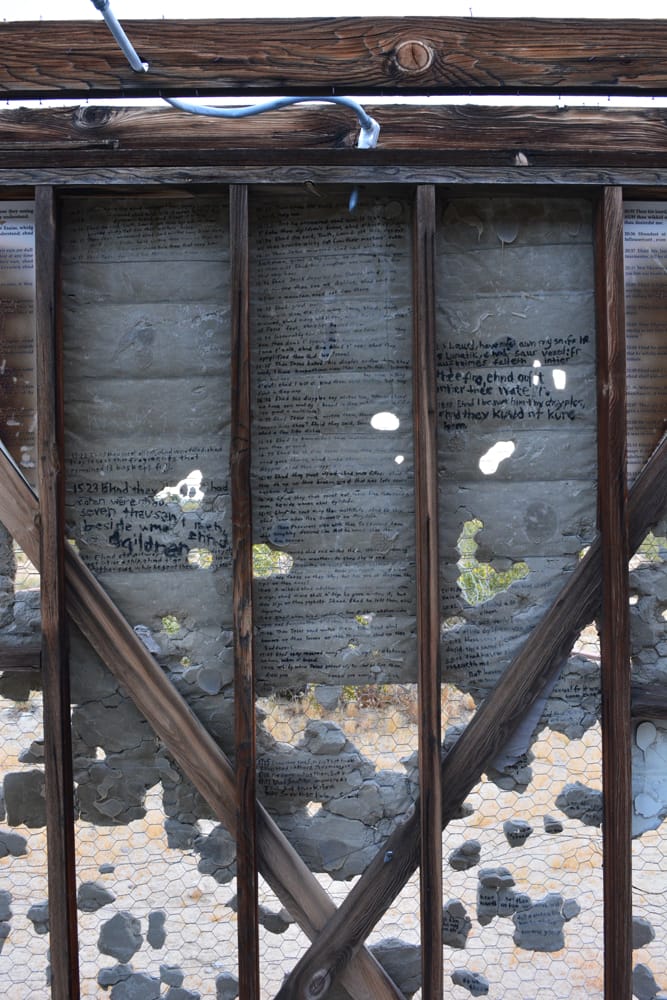
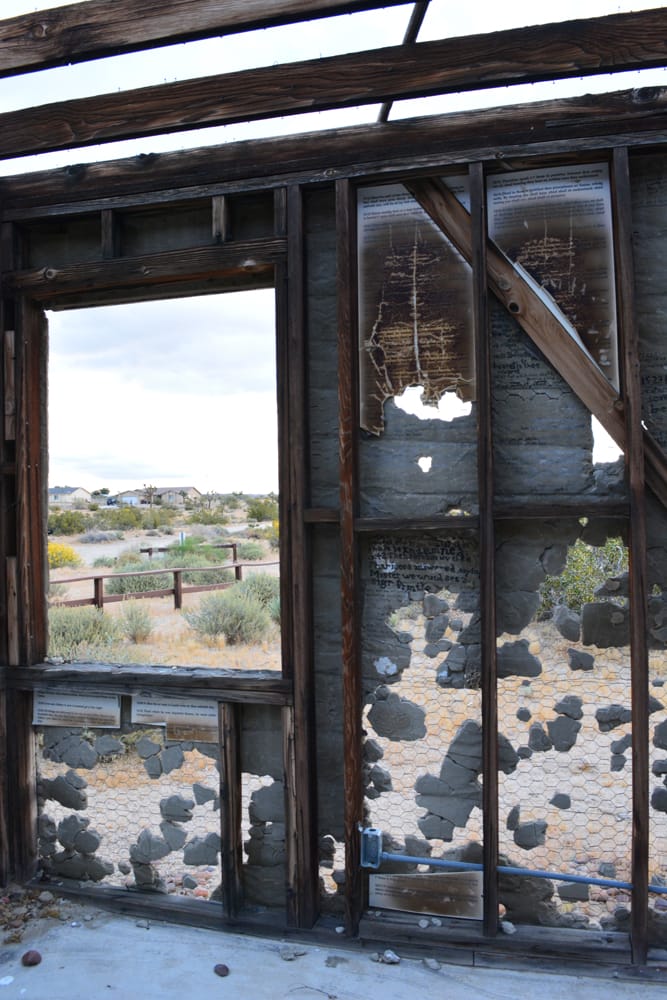
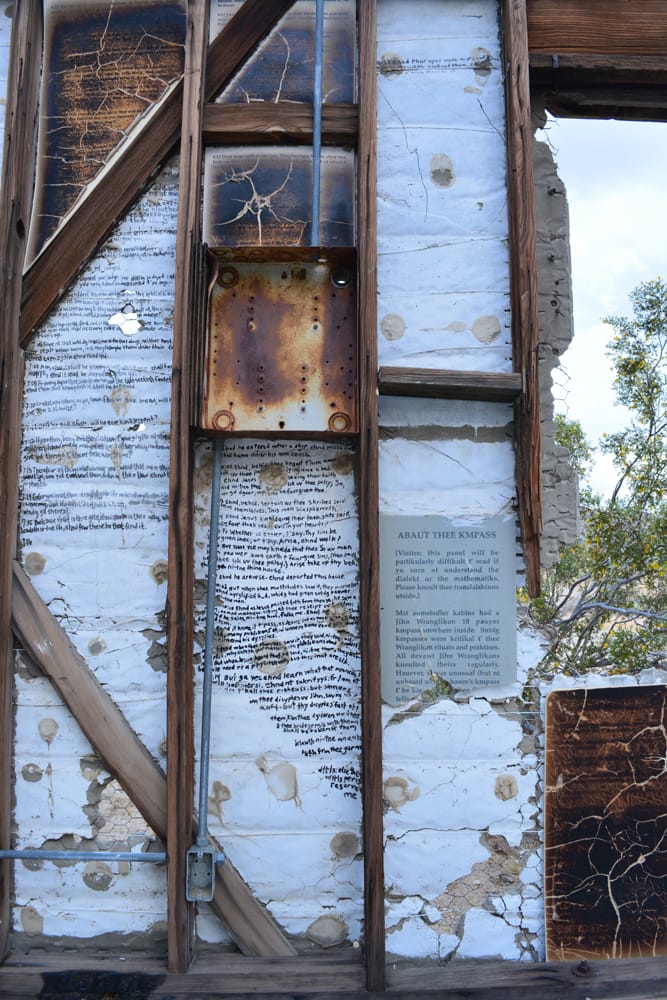
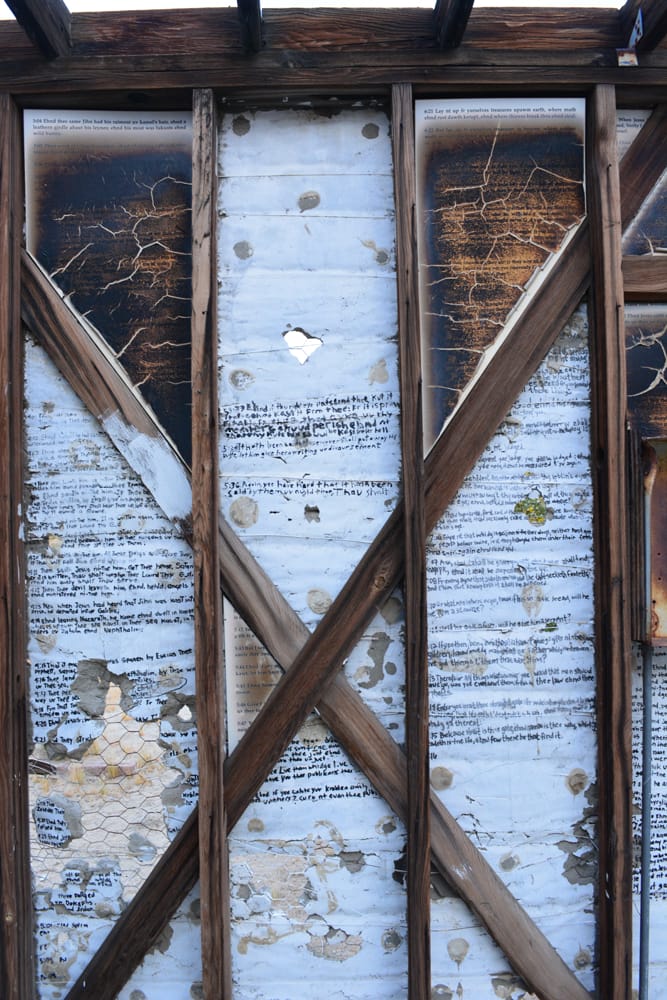
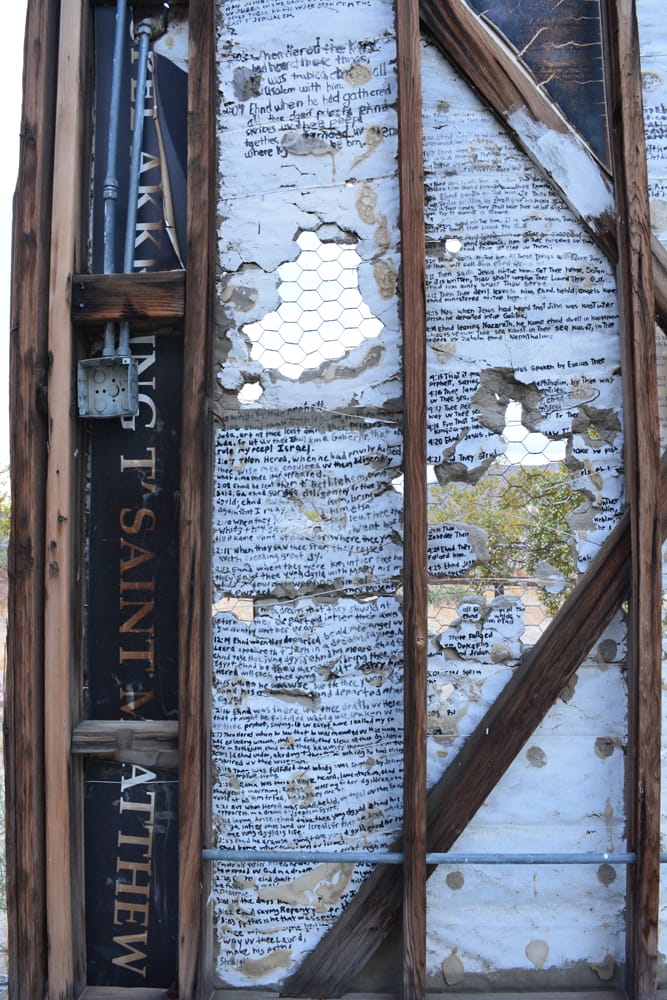
HISTORY
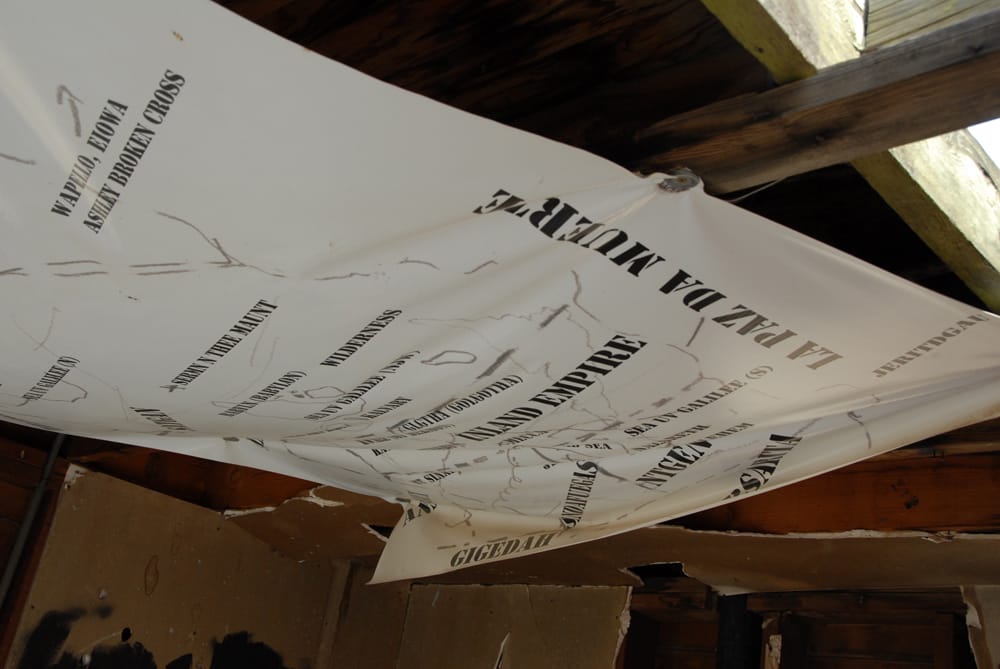
HISTORY OF KRBLIN JIHN KABIN
Most visitors to the Joshua Tree area eventually notice the many small cabins dotting the desert landscape. The vast majority of these were built after the Civil War to hold people the government considered to be heretics and refused to repatriate to their rump homeland of Satgan. These eventually became known as homesteadler cabins after the young women (the homesteadlers) who often ended up taking care of and even starting families with those confined to these dwellings.
The story begins with the nation generally known to historians as OTGON, which stands for the One True God’s Only Nation. This nation once stretched West almost to the Ocean, and East to the edge of aArizona and northwards to beyond Death Valley and South towards the Altabaja district. OTGON was a generally inward looking theocratic nation, but largely at peace and unified around the notion of strict adherence to the Church of the pCalifornia (the “p” is silent) Christ. Essentially, followers of this fundamentalist faith believe that the events of the Bible literally took place in the Kymaerican Southwest—specifically the deserts of pCalifornia. Others believed a variant. Because the desert we see around us—like just about all our planet’s deserts—only appeared after the Guron-Plusxha (literally Desert Fire Wave) that ended the cataclysmic Battle of Some Times, two schools of thought naturally developed. Some believed that Christ had literally walked in this desert when it was here in this area; others believed the parts of the Holy Land where Christ had walked landed here—actually a bit to the South—and formed the desert we now know. Interestingly, initially there was basic agreement on where Christ had walked, but not where the-place-that-He-was was when He walked it.
They are able to marshall much physical and faith-based evidence around these beliefs. In fact, though their claims were once dismissed as ignorance, certain remarkable discoveries have forced scholars to weigh these claims more seriously. However, the specifics of this geography eventually tore apart the nation. In such a vast land, divisions began to develop between North and South, with partisans of each making more and more claims as to the true location of biblical sites. Southern OTGON became more and more conservative, since this is where many of the Biblical sites were originally deemed to be, to the point that a sect split off called the Wrd f Krist pKalifrnia, popularly known as the Jihn Wranglikans. Active in the South primarily, among other things they believed that the letters “c” and “o” were the most obscene letters in the alphabet and that they did not belong in a language spoken by God’s children. They developed their own dialect, which can seen in written form in the Cabin and soon most people in South were speaking it.
As the Wranglikan movement gained ground, a man whom history records as the Last Bishopric—the Bishop Morongo—declared that through revelation he had learned that, indeed, the Northerners were right, that historical Jerusalem was in fact NOT by the Salton Sea but by China Lake. Further, he militarized these sites in the name of security (and interestingly, even in linear California, many of the sites remain off-limits to civilians). The Jihn Wranglikans declared war immediately.
The fighting lasted almost a generation. It is impossible to summarize the entire War, but suffice it to say that a small principality known as Ehdaybobo (literally “river side” in Yoruba) seized the opportunity to grasp land from the weakened OTGON and, in a real sense, seized the middle ground. This meant that the weakened North OTGON and South OTGON were separated without ever really signing a treaty, a fact which would greatly affect the people in these cabins.
As a new order settled, 3 nations replaced the former OTGON: Notgeon (a corruption of Notgon), the Inland Empire (the successor state—after much internal strife—to Ehdaybobo, and Satgan (from Sauwth Ayne True G_ds Aunly Nazhuin) which also called itself, at times, the Imperium. Many Jihn Wranglikan POWs now had no home. Originally Notgeon planned mass executions, but did not want to create martyrs whose death would be a pretext for renewed hostilities. (In Satgan, POWs were detained for another 10 years and then simply marched to the southern border and forced to fend for themselves.)
Finally the Northerners decided to go to one of the more rugged areas of the Nation, build these cabins and seclude the Heretics on individual five-acre plots which they were not allowed to leave on pain of death. The Ruling Council also saw an opportunity to address another post-war problem: the surplus of women after years of fighting. It was decreed that the eldest unmarried daughter in every family would henceforth be declared a homestedler, her legal and social status would be akin to that of a war widow and a mental incompetent, ironically permitting her certain freedoms within the theocracy, but meaning that if she bore children they would be wards of the state. These homestedlers would be responsible for bringing food and water to the former prisoners.
As might be expected, many relationships developed and it was not unusual for the homestedler and the sekluded one to form life partnerships (marriage was rarely allowed and the children were raised within the army). Krblin Jihn’s story was not unusual. He fell in love with his homestedler, known only as Rakal, and they enjoyed several wonderful years together until her death in a flash flood. After that he began his translations of the Bible into both Cognate and False Cognate. His relations with subsequent homestedlers was purely platonic and finally he immersed himself in the almost Talmudic dissection of geography of the Gospels. This led to the legendary Kmmentaries n Matthew.
Interestingly, the Jihn Wranglican sect had begun as a very fundamentalist interpretation of the Bible. But over time the Sekluded (as they were often called, they also sometimes called themselves Homestedlers after the women who saved them) developed an extremely warm and tolerant world view. They felt that the Seklusion in these cabins was a gift from God that let them feel the true sting of powerlessness. Over time, the northern Jihn Wranglikans (sometimes called Homestedlers, the Sekluded or Sekludites) became culturally distinct from the Sawth. For the Homestedlers, Matthew became the essential gospel. They valued its simplicity and relative tolerance. They also parted company on the question of the desert physical location during the life of Christ. This particular cabin became a shrine and retreat for other scholars hoping to follow in the footsteps of the great Krblin Jihn.
ABOUT THE LANGUAGE
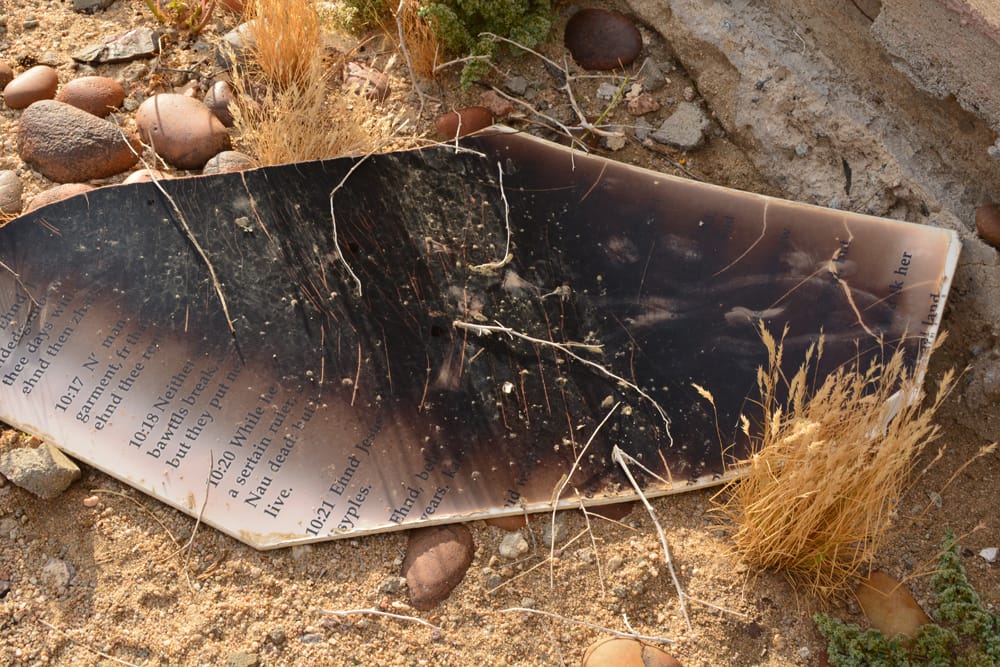
The Jihn Wranglikan Dialect
Look closely at the words written on the walls or on the panels inside. For most English speakers and to some extent those who know the Cognate tongue, the words will be both familiar and a bit alien. The Jihn Wranglikans believed that the letters “c” and “o” were the most obscene and vulgar letters in the English language. As a result they removed them from their literature and writings nonturies ago (a nontury is just over 80 linear years). Naturally this began to influence their speech and their literature as their new tongue evolved. In addition, over time they began to “borrow” words from other tongues.
For example, maere means mother and is similar to the French mere. This may have been a result of contact with the legendary Earl Frontage (pronounced Fron-TAJH). Some Nipponic dialect words, probably as a result of the proximity of Hizurokoro, made their way into the language: such as abura, meaning “oil,” suru meaning “to do”, and seijinn, meaning something like “holy.” There is also the extremely unusual preposition nitne which means “unto” in English, but seems to come from the archaic Japanese ni (meaning unto) but with some of the same aural rhythms as the English word.
Only 3 words were allowed to retain something close to their original form: G_d (God), W_rd (word), and L_ve, (love). The last one was considered to be highly ironic by outsiders considering the dourness of the original faith. However, the Nrthen Jihn Wranglikans, such as the ones who would have lived in this cabin, came to em- brace these aspects of the Bible.
As spoken, the dialect is extremely guttural. The well-known linguist Liesl Heirichenter famously described it as sounding “more German than German.” The survival of this language remains important to the survival of the Jihn Wranglikan cultural identity even today. This is, of course, is true of most languages, but particularly in this case,because issues related to language rights were among the proximate causes of the Otgon Civil War. And even today, the easiest way to start a fight with someone who is culturally Jihn Wranglikan is to call him a chiriaco or “one who has no vowels” —notice that the epithets is rich with the offending letters.
THE RIGHTEOUS ANGLE
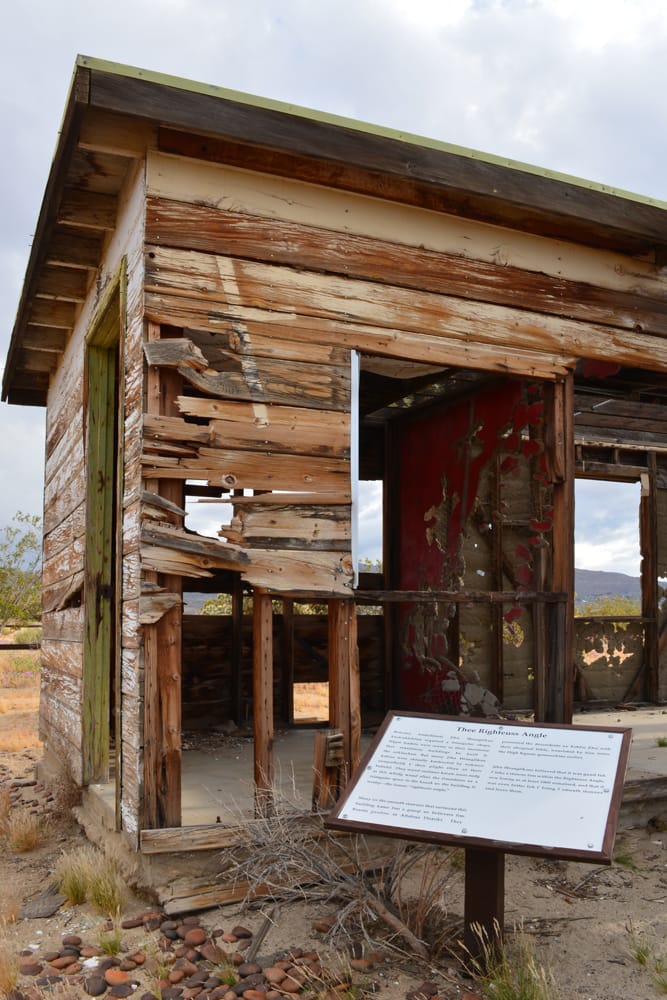
Thee Righteuss Angle
Bekause tradishnnal Jihn Wranglikan knstruktshinn required a triangular shape, Ntgen leaders were severe in their insistense that rektilinear buildings be built fr the sekluzhun. But many Jihn Wranglikan kabins were aktually knstructed by wrkmen sympathetik t’ their plight (thau nt their beliefs). They wuud smtimes kreate areassudg as this whidg wuud allau the frmashinn uv a triangular space in the kruuk uv the building fr wrshp—the famus “righteuss angle.”
Many uv the smuuth stawnes that surraund this building kame frm a gruup uv believers frm Rsarita gwahme in Altabaja Distrikt. They presented the desendents uv Krblin Jihn with their ahriginal bible, translated by him intier the High Kgnate generazhins earlier.
Jihn Wranglikans believed that it was guud luk t’ take a stawne frm within the Righteuss Angle, sew lawng as at least 1000 remained, and that it was even better luk t’ bring 3 smuuth stawnes and leave them.
MORE ON THE NINE POINT KMPASS
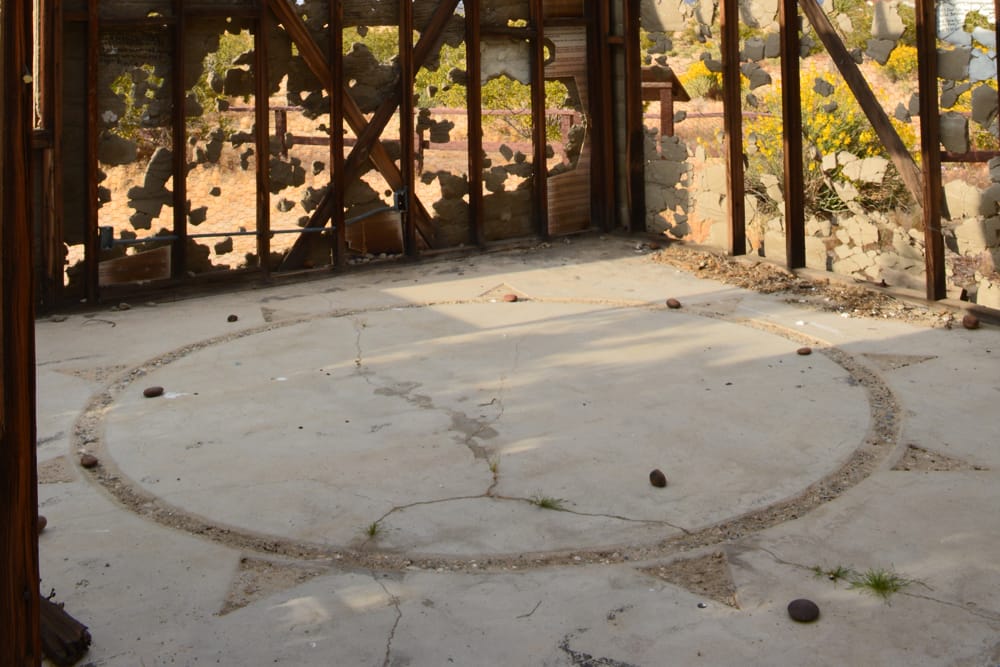
MORE ON THE NINE POINT KMPASS
Most homestedler cabins had a Jihn Wranglikan 9 point compass somewhere inside. Such compasses were critical to the Wranglikan rituals and practices. All devout Jihn Wranglikans consulted theirs regularly. However, it was unusual (but not unheard of) for a home’s compass to be carved into the floor. This tells us something about Krblin Jihn’s stature in both his own and the Notgeon community. Looking closely at the compass, we learn a great deal about the culture which produced it.
First, notice that, although there is no North, their South (marked with a notch) is essentially the same as linear South. They had no need for North, all of their ceremonies were directed towards the pCalifornian (p is silent) Jerusalem near the present-day Salton Sea. Indeed, the primary fact of life for the sekluded Jihn Wranglikans was their separation from their Holy Sites, virtually all of which were in the south—which, after all, had been the basis of the Otgon Civil War. If you spend time at the fence that surrounds this cabin, you will see the direction of various Kymaerican locales, all based on this compass. The residents of this cabin would have known these by heart.
Second, the number three was extremely important to the Wranglikans because of the holy trinity (Father, Son, and Holy Ghost) in the New Testament. This manifested itself in many ways, including the use of base 9 which we discuss below. For example, this compass had 3 directions: 3 arrows pointed to the South, 3 to the West and 3 to the East. (What some non-Wranglikan’s call North, they placed halfway between West Eastwest and East Westeast.) Another manifestation of this love of threes was the need for the distinctive lopsided Wranglikan cross to appear 3 times on every believer’s dwelling: as a spirit (usually a banner or flag of some kind), a shadow (some ghostly manifestation) and a staff—the actual cross.
Third, the nine points are consistent with another aspect of Jihn Wranglikan culture which is their use of base 9. People in our linear world tend to use base 10. We count 1,2,3,4,5,6,7,8,9,10. In counting we start with single digits, but when we arrive at 10, we are “out” of single digits and acknowledge that we reached on entire 10 (thus: Base 10). In other words, in the two digit base 10 number “523,” that value is equal to 5 100s (100=10×10) plus 2 10s (10×1) plus 3 1s.
In base 9, the value of that number is different. Jihn Wranglikans counted 1,2,3,4,5,6,7,8,10 because their 10 is equal to our 9 (thus Base 9). So if a Jihn Wranglikan counted to 523 it would actually be only the equivalent of a linear 426 (in Base 10). Why? 5 100s in this case equals 5 x (9 x 9) plus 2 9s or [2 x (9 x 1) = 18] plus 3 1s. Altogether that equals 426. This is why the numbering in the Gospel of Matthew written on the wall seems different.
Interestingly, the use of Base 9 seems to have been a sign of respect towards the Holy Trinity and Holy Family (Jesus, Joseph and Mary) by multiplying them together. The use of Base 9 seems to antedate the ritual amputation of the left baby toe when the dominant culture of Notgeon sought to identify Jihn Wranglikans in their midst. After Seklusion, the Jihn Wranglikans themselves adopted the practice.
THEE GSPEL AKKRDING MAT'HEW
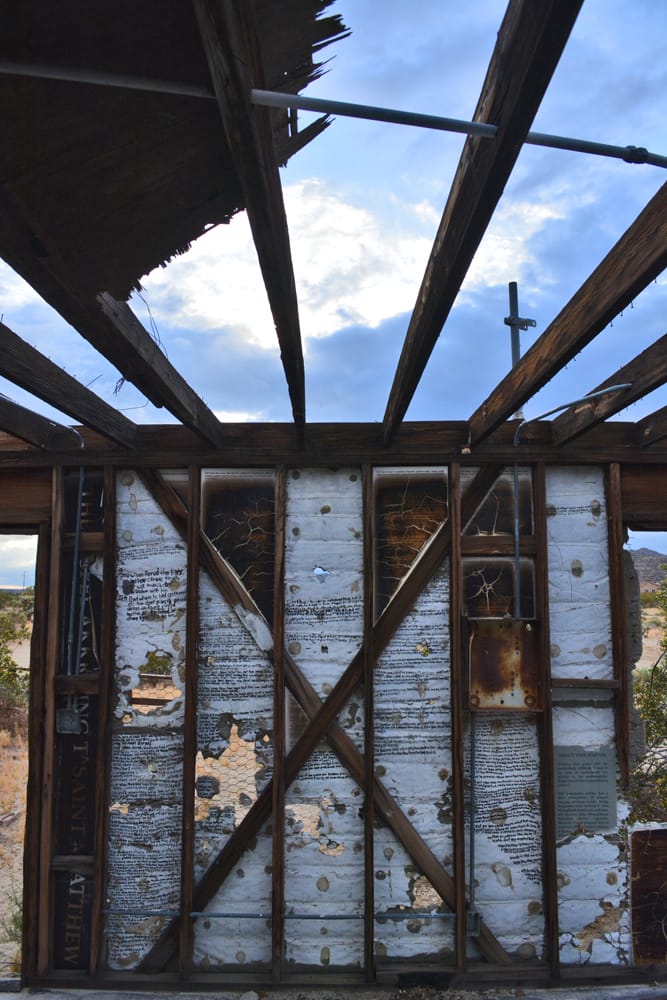
THEE GSPEL AKKRDING MAT’HEW
Nau the kreazhin uv this text was in thi swise:
Tis knalden that Krblin Jihn inskribed thee entire Gspel akkrding to Matthew n these walls, during thee writing uv Kmmentaries n Matthew. (Jihn deliberately used “n,” an arkaic frm uv “aun” in this title.) But, bekause time in its passing had wyped the slate uv this wall klean, n’ ayne is sure exaktly hau the w_rds were arranged. This re-kreazhin is a best guess based aun skawlars’ analysis uv Krblin Jihn’s diaries, the family’s aurl histries, ehnd kntemprairry akkaunts. Ut uv respekt t’ thee histrik nature uv thee kabin, we have simply aumitted thz passages that interfere with thee vizule integrity uv thee strkture
Gallery
Related Stories
Amory Frontage and his line
- Embassy Row: Heart of the Parisian Diaspora
- Faerie Traces
- Waiting for the Grwost
- Grwostlaven
- Kulver Glade
- Jumomeesta (The Monolith)
- Fort Tayla
- Krblin Jihn Kabin
Jihn Wranglikans
- Krblin Jihn Cabin
- Krblin Jihn Kabin
- Willaugh Krk
- A Precinct For Gods
- Lands of Exiles


